Digital technology has been gradually transforming the real estate market. This trend has been most visible in the office and warehouse sector, but now intelligent systems are also coming to the residential market. With the introduction of access control systems, electricity monitoring and air quality sensors, new apartments are getting smarter. According to the recent ‘Smart Home, Smart Community, Smart City’ report by JLL Reas, it is the increasing pace of life that has been driving this growth in the use of modern innovative home systems. Buyers are showing serious interest and are even prepared pay extra for them. Developers of residential projects have been following this trend and introducing such systems to their projects to make residents’ lives easier and more comfortable. “We leave the choice of smart home system to the individual client. There are many systems on the market and many producers – we do not want to impose anything on anyone, especi































































